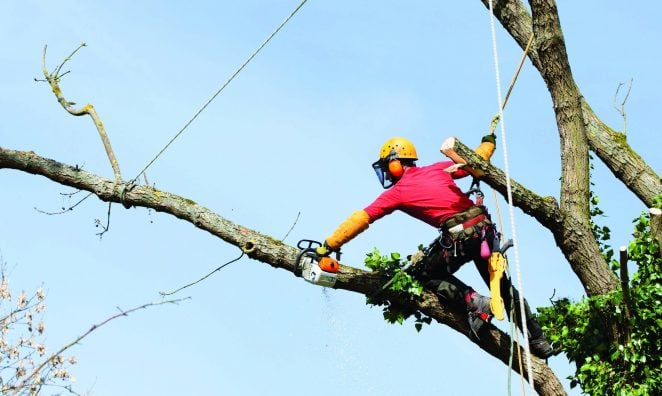
Ohio laws address a variety of issues including overhanging tree limbs and trimming neighbor's trees. The best practice is to work cooperatively with neighbors to address concerns you may have about the trees on or near your property lines.

Here are some answers to our most common questions about Ohio laws regarding trees and property rights. This article was reviewed in May, 2024 and the information is still correct.
Yes, property owners are always entitled to clear the airspace above their property of overhanging tree limbs. However, this right is limited by the rights of neighbors as well. It is important to make sure you are not trespassing while doing the trimming — either by stepping onto the neighboring property, placing debris on the neighbor’s property or trimming parts of the tree that are on the neighboring property. Trimming should be done with care to not cause any reckless damage to the tree as well.
The law states that a person is prohibited from recklessly damaging a tree on another’s property without permission to do so. The law provides that doing so is a fourth-degree misdemeanor, carrying a penalty of up to $250 and/or 30 days in jail. Ohio law also allows that, in addition to this penalty, anyone who violates the law can be subject to damages up to three times the worth of the tree that was harmed. These damages could be awarded through criminal prosecution as restitution, or through a civil lawsuit filed by an individual.
The law is unclear on whether landowners can remove a tree themselves when it sits on a property line. Under the Ohio tree laws, trees are considered a part of the property and landowners have a right to that tree, even if it is only halfway on the property. Because of this, it is best practice to get a neighbor’s permission before removing any tree that sits on the property line. This also can facilitate a discussion of who will pay for the removal, the need to enter onto property to safely remove the tree and disposal of the tree and any debris. Discussing the details ahead of time can save money and frustration afterward.
Liability is always a question for a court to determine. However, typically landowners are not liable for damage caused by a falling tree from their property so long as they had no reason to believe it was likely the tree would fall. A tree that is healthy, but for example, is struck by lightning and falls or is toppled by strong winds, will likely not be the fault or responsibility of the landowner. If it is obvious that a tree poses a serious risk of falling, due to damage, disease or even being dead, the landowner might have responsibility for it falling.
If a tree falls on a line fence, Ohio law is not clear on who is responsible for repairing the fence. In the best case scenario, the adjoining landowners should come to an agreement (or have a written agreement already in place) to determine who will pay for the cost of fence repair. If the landowners cannot agree, one or both of the landowners can file a complaint with the township trustees or the court to settle the dispute. It is important to remember though, that livestock owners always are responsible for ensuring their livestock is properly contained — even when a line fence maintenance dispute is on-going.
Probably not. It is likely that a utility company has a right of way or easement across your property in order to service and maintain the utility infrastructure. Trees are typically an issue with electric or phone lines, and power companies often must trim the trees in order to ensure they do not threaten to fall onto or damage the utility lines. If landowners have questions, they should consult the language of the right of way or easement to ensure that the utility has the ability to maintain the trees within or which overhang the easement or right of way. However, if the utility has the right under the language of the right of way or easement, landowners cannot prevent them from exercising that right. This is true even if the utility company has not recently, or ever, trimmed the trees in the past.
Legal with Leah: Trees and property rights